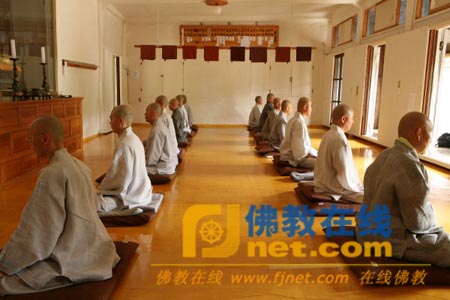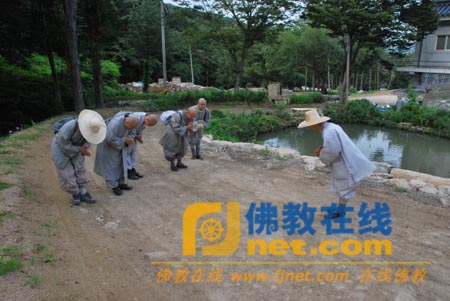韩国曹溪宗长达三个月的夏季闭关禅修圆满结束

夏季闭关禅修
禅修结束 拜别师傅
开始苦行
据《韩国曹溪宗网站》报道,2009年8月5日早晨,韩国曹溪宗长达三个月的夏季闭关禅修随着Beopjeon法师的开示圆满结束。
2009年,韩国共有禅寺95所,僧侣2237人。韩国佛教修习的传统是要在夏季闭关禅修三个月,秋季行脚三个月、冬季禅修三个月之后春季再继续行脚。而这三个月密集的修习被叫做kyolche,意味着紧密的修习。kyolche以后的三个月被叫做manhaeng,意味着到处旅行。在三个月的禅修中,僧侣们可以和他们的本性接触,就像重新充电一样,使他们成熟以应对将以轻松愉快的方式度过的manhaeng。在行脚的三个月中,他们没有放松修行的精神。但是艰苦集中的修习减少了,他们可以去朝拜或以其他较为轻松的方式修习。之后他们将返回到严谨的闭关禅修季节来恢复他们对悟道的热情。据悉,这种奇妙的传统可以追溯到佛陀时代,那时僧侣们在雨季不能出行,只能呆在寺院中禅修直至雨季结束。(编译:子规)
The three-month summer retreat ended on the morning of August 5 (full moon day) with a closing Dharma Service. Across the nation at 95 meditation temples (Seon Bang), 2237 monks and nuns practiced Seon meditation in 2009. The Korean Buddhist practice tradition is to meditate in the summer for three months, travel (manhaeng) for three months in the fall, meditate for three months in the winter, and again travel for three months in the spring. The three months of intensive meditation is called kyolche, meaning tight practice, and the three months of off-season is called manhaeng, meaning moving around. In three months of meditation, the monks and nuns get back in touch with their fundamental nature. It’s like recharging the batteries. It matures them for the off-season, which is spent in a relaxed and joyous manner. They do not lose the practicing spirit, but the arduous and focused practice is loosened. They may do pilgrimages and other lighter practices. Then, they return to a seriousness of the retreat season to renew their zeal for enlightenment. This wonderful tradition goes back to the time of Buddha when the monks and nuns could not travel during the rainy season. They would stay in their huts to meditate until the rain stopped.
The Dharma Talk to End the Summer Retreat 2009
欢迎投稿:307187592@qq.com news@fjdh.com
QQ:437786417 307187592 在线投稿
2.佛教导航欢迎广大读者踊跃投稿,佛教导航将优先发布高质量的稿件,如果有必要,在不破坏关键事实和中心思想的前提下,佛教导航将会对原始稿件做适当润色和修饰,并主动联系作者确认修改稿后,才会正式发布。如果作者希望披露自己的联系方式和个人简单背景资料,佛教导航会尽量满足您的需求;
3.文章来源注明“佛教导航”的文章,为本站编辑组原创文章,其版权归佛教导航所有。欢迎非营利性电子刊物、网站转载,但须清楚注明来源“佛教导航”或作者“佛教导航”。



